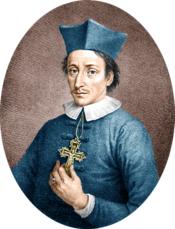Nicolaus Steno
Nicolas Steno[1] (1 January 1638 – 25 November 1686; NS: 11 January 1638 – 5 December 1686) was a Danish Catholic cleric and scientist who pioneered in both anatomy and geology.
Nicolas Steno | |
|---|---|
 Nicolas Steno | |
| Born | 1 January 1638 |
| Died | 25 November 1686 (aged 48) |
| Nationality | Danish |
| Scientific career | |
| Fields | Anatomy and geology |
In 1659 he decided not to accept anything written in a book and, instead, decided to find out things for himself.[2] He is considered the father of geology and stratigraphy.[3]4; 96

Fossils and geology
changeSteno argued that the chemical composition of fossils could be altered without changing their form.
Steno's work on shark teeth led him to the question of how any solid object could come to be found inside another solid object, such as a rock or a layer of rock.
The "solids within solids" that attracted Steno's interest included not only fossils, as we would define them today, but minerals, crystals, even entire rock layers or strata.
He published his geologic studies in 1669: De solido intra solidum naturaliter contento dissertationis prodromus, or Preliminary discourse to a dissertation on a solid body naturally contained within a solid.
Steno was not the first to identify fossils as being from living organisms. His contemporaries Robert Hooke and John Ray also argued that fossils were the remains of once-living organisms.[4]
Steno wrote about some of the fundamental principles of stratigraphy:
- Superposition: "...at the time when any given stratum was being formed, all the matter resting upon it was fluid, and, therefore, at the time when the lower stratum was being formed, none of the upper strata existed";
- Horizontality: "Strata either perpendicular to the horizon or inclined to the horizon were at one time parallel to the horizon";
- Lateral continuity: "Material forming any stratum were continuous over the surface of the Earth unless some other solid bodies stood in the way";
- Cross-cutting discontinuities: "If a body or discontinuity cuts across a stratum, it must have formed after that stratum".[5]
Related pages
changeReferences
change- ↑ Danish: Niels Stensen; Latinized to Nicolaus Stenonis, Italian: Niccolo' Stenone
- ↑ Kooymans, L. 2007. Gevaarlijke kennis. Inzicht en angst in de dagen van Jan Swammerdam. Information from Steno's diary, called Chaos, written around 1659, and discovered in 1946 in a Florence library
- ↑ Woods, Thomas 2005. How the Catholic Church built western civilization. Washington, DC: Regenery. ISBN 0-89526-038-7
- ↑ But Ray retracted his correct idea when religious friends pleaded with him.
- ↑ Paul Eric Olsen, Columbia University